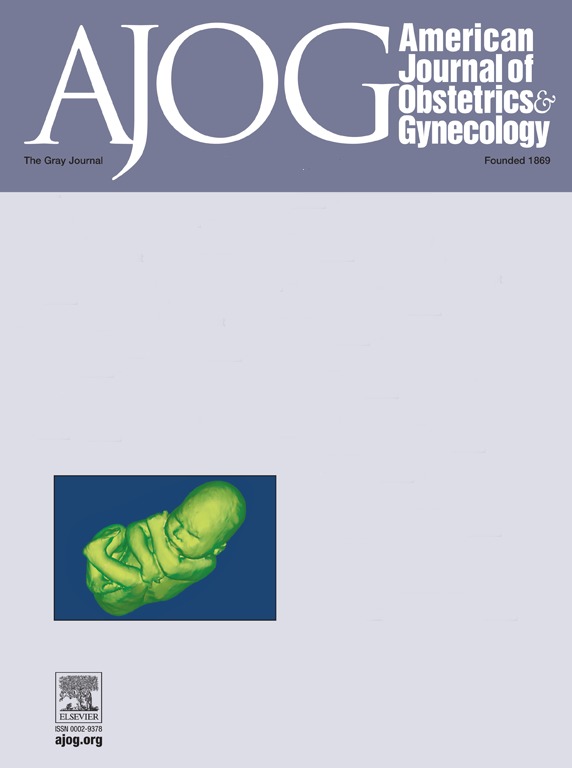卵巢癌组织学特异性自然史模型的建立与验证。
IF 8.7
1区 医学
Q1 OBSTETRICS & GYNECOLOGY
引用次数: 0
摘要
背景:卵巢癌是妇科癌症死亡的第二大原因,但目前还没有针对普通人群的有效筛查方案。过去的筛查试验评估了年度卵巢癌筛查的有效性,并得出结论认为它不会显著降低死亡率。未来对卵巢癌筛查试验的投资将需要对相关干预措施的有效性提供令人信服的初步证据。模拟建模提供了一种有效、快速、经济、安全的方法来了解干预措施的有效性,这越来越多地被用于癌症筛查项目的指导方针。在没有任何干预的情况下模拟疾病自然进展的模型,通常被称为自然历史模型(NHMs),是这种分析的基石,因为它们为评估干预提供了参考点。目前,尽管卵巢癌亚型之间存在显著差异,但没有组织学特异性的NHM存在。目的:开发并验证一种组织学特异性卵巢癌NHM。研究设计:我们为上皮性卵巢癌最常见的组织学亚型开发了NHMs:高级别浆液性癌、低级别浆液性癌、黏液性癌、透明细胞癌、子宫内膜样癌、癌肉瘤,以及其他未指明的亚型。每个NHM模拟卵巢癌从发病到任何原因导致死亡的自然进程。我们将卵巢癌的进展建模为一个由13个相互排斥和共同详尽的健康状态组成的状态过渡模型。我们尽可能使用观测到的、具有全国代表性的估计来告知模型输入参数。通过校准来自监测、流行病学和最终结果(SEER)登记的组织学特异性数据来估计未观察到的参数(例如,临床前转变)。我们在前列腺、肺癌、结直肠癌和卵巢癌筛查试验(PLCO)和英国卵巢癌筛查合作试验(UKCTOCS)试验的对照组中验证了NHMs,包括卵巢癌发病率和死亡率,以及诊断时的分期分布。观察结果和估计结果之间的差异使用传统的统计检验进行评估。结果校准后的NHMs重现了观察到的SEER数据(各组织学亚型的加权均方根误差(RMSE)范围:0.0081至0.0185)以及单个校准目标;诊断后生存率、诊断时分期分布和诊断时年龄分布(各组织学亚型的RMSE范围分别为0.0029 ~ 0.0204、0.0005 ~ 0.0203和0.0637 ~ 0.0816)。NHMs重现了PLCO观察到的发病率和死亡率、诊断时分期(发病率p值=0.411,死亡率p值=0.195,诊断时分期分布p值=0.200)和UKCTOCS观察到的卵巢癌发病率(p值=0.607)和死亡率(p值= 0.624)。临床前阶段的平均持续时间在1-3年之间,这部分解释了筛查未能降低死亡率的原因。此外,在所有亚型中,II期卵巢癌是一种短暂状态,与其他阶段相比,其平均持续时间明显较短。结论NHMs准确地描述了卵巢癌的组织学特异性自然进展,并为卵巢癌的自然历史提供了重要的见解。开发的模型可用于评估未来和新出现的卵巢癌干预措施的影响,从而为决策者和政策制定者提供有价值的见解。本文章由计算机程序翻译,如有差异,请以英文原文为准。
Development and Validation of a Histology-Specific Natural History Model of Ovarian Cancer.
BACKGROUND
Ovarian cancer is the second leading cause of death from gynecologic cancers, yet no effective screening program exists for the general population. Past screening trials evaluated the effectiveness of annual ovarian cancer screening and concluded that it does not yield significant mortality reduction. Future investments on ovarian cancer screening trials would require convincing preliminary evidence on the effectiveness of interventions of interest. Simulation modeling offers an effective, fast, cost-efficient, and safe approach to gain insights on the effectiveness of interventions, that is increasingly being used to inform guidelines for cancer screening programs. Models that simulate the natural progression of diseases in the absence of any intervention, commonly referred to as natural history models (NHMs), are the cornerstone of such analyses because they provide a reference point for evaluating interventions. Currently, no histology-specific NHM exists for ovarian cancer despite significant differences among subtypes.
OBJECTIVE
Develop and validate a histology-specific ovarian cancer NHM.
STUDY DESIGN
We developed NHMs for the most common histological subtypes of epithelial ovarian cancer: high-grade serous carcinoma, low-grade serous carcinoma, mucinous carcinoma, clear cell carcinoma, endometrioid carcinoma, carcinosarcoma, and not otherwise specified. Each NHM simulates the natural progression of ovarian cancer from disease's onset until death from any cause. We modeled ovarian cancer progression as a state-transition model comprising of 13 mutually exclusive and collectively exhaustive health states. We informed the model input parameters using observed, nationally representative estimates, whenever possible. Unobserved parameters (e.g., preclinical transitions) were estimated through calibration to histology-specific data from the Surveillance, Epidemiology, and End Results (SEER) registry. We validated the NHMs on the control arms of the Prostate, Lung, Colorectal and Ovarian Cancer Screening Trial (PLCO) and the United Kingdom Collaborative Trial on Ovarian Cancer Screening (UKCTOCS) trials, in terms of ovarian cancer incidence and mortality rates, and stage distribution at diagnosis. Differences between observed and estimated outcomes were assessed using traditional statistical tests.
RESULTS
The calibrated NHMs reproduced the observed SEER data (range of weighted root mean square error (RMSE) across histological subtypes: 0.0081 to 0.0185) as well as individual calibration targets; survival after diagnosis, stage distribution at diagnosis, and age distribution at diagnosis (ranges of RMSE across histological subtypes: 0.0029 to 0.0204, 0.0005 to 0.0203, and 0.0637 to 0.0816, respectively). The NHMs reproduced PLCO's observed incidence and mortality rates, and stage at diagnosis (p-value=0.411 for incidence, p-value=0.195 for mortality, and p-value=0.200 for stage distribution at diagnosis) and UKCTOCS's observed ovarian cancer incidence (p-value=0.607) and mortality (p-value = 0.624) rates. The average duration of the preclinical phase ranges between 1-3 years, which partly explains screening's failure to yield mortality reduction. Moreover, across all subtypes considered stage II ovarian cancer is a transient state with significantly shorter average duration as compared to other stages.
CONCLUSION
The NHMs accurately describe the histology-specific natural progression of ovarian cancer and provide important insights into the natural history of the disease. The developed models may be used to evaluate the impact of future and emerging ovarian cancer interventions, thus providing valuable insights to decision-makers and policy-makers.
求助全文
通过发布文献求助,成功后即可免费获取论文全文。
去求助
来源期刊
CiteScore
15.90
自引率
7.10%
发文量
2237
审稿时长
47 days
期刊介绍:
The American Journal of Obstetrics and Gynecology, known as "The Gray Journal," covers the entire spectrum of Obstetrics and Gynecology. It aims to publish original research (clinical and translational), reviews, opinions, video clips, podcasts, and interviews that contribute to understanding health and disease and have the potential to impact the practice of women's healthcare.
Focus Areas:
Diagnosis, Treatment, Prediction, and Prevention: The journal focuses on research related to the diagnosis, treatment, prediction, and prevention of obstetrical and gynecological disorders.
Biology of Reproduction: AJOG publishes work on the biology of reproduction, including studies on reproductive physiology and mechanisms of obstetrical and gynecological diseases.
Content Types:
Original Research: Clinical and translational research articles.
Reviews: Comprehensive reviews providing insights into various aspects of obstetrics and gynecology.
Opinions: Perspectives and opinions on important topics in the field.
Multimedia Content: Video clips, podcasts, and interviews.
Peer Review Process:
All submissions undergo a rigorous peer review process to ensure quality and relevance to the field of obstetrics and gynecology.

 求助内容:
求助内容: 应助结果提醒方式:
应助结果提醒方式:


